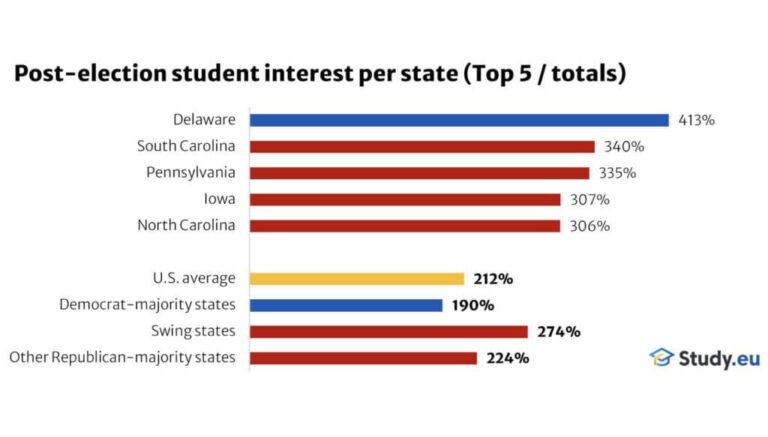Student interest in pursuing higher education in the United States is showing a notable decline, according to recent data released by StudyTravel Network. The trend, reflecting shifting global dynamics and increasing competition from other education destinations, raises concerns about the future landscape of American universities. This development comes at a critical time as institutions grapple with enrollment challenges and strive to maintain their position on the world stage.
Student Enrollment Trends Reveal Shifting Priorities Among Prospective US Students
Recent data highlights a notable shift in the preferences of prospective students looking at US higher education institutions. While the overall number of enrollments dips, the interest in specific fields and study modes is evolving rapidly. Many students now prioritize flexible learning options such as online and hybrid programs over traditional on-campus experiences, reflecting changing lifestyles and the persistent impact of the global pandemic. Additionally, cost-effectiveness and return on investment have become key decision-driving factors, pushing students to look closely at courses offering accelerated paths or targeted skills for emerging industries.
Institutions are responding to this trend by adapting their offerings and marketing approaches. Key shifting priorities include:
- Sustainability and social impact programs: Growing demand for courses addressing climate change and community engagement
- STEM disciplines: Continued strong interest, especially in computer science and data analytics
- Career services enhancement: Emphasis on internships, apprenticeships, and job placement support
| Priority Area | Change in Interest (2023 vs 2022) |
|---|---|
| Online/Hybrid Learning | +18% |
| Social Impact Programs | +12% |
| Traditional Campus Experience | -15% |
| STEM Fields | +7% |
Economic Factors and Pandemic Aftereffects Drive Decline in Higher Education Interest
Amid ongoing economic uncertainty and the lingering repercussions of the COVID-19 pandemic, prospective students are demonstrating waning enthusiasm toward enrolling in higher education institutions across the United States. Rising tuition fees combined with the increased cost of living have forced many to reassess the value proposition of college degrees. Additionally, the pandemic-induced shift to remote learning has altered perceptions of campus life quality, steering potential applicants to consider alternative career paths or shorter vocational training programs. Employers’ growing emphasis on work experience over formal qualifications further compounds the trend, creating a complex landscape for universities struggling to maintain enrollment figures.
The following table highlights key economic and social drivers contributing to this shift:
| Factor | Impact on Enrollment |
|---|---|
| Tuition Inflation | Decreased affordability leads to deferred enrollment |
| Remote Learning Fatigue | Declined motivation due to lack of campus experience |
| Job Market Shifts | Increased preference for skills-based hiring over degrees |
| Financial Aid Uncertainty | Students cautious about loan debt amidst economic volatility |
Universities are responding by exploring flexible programs and emphasizing career-aligned curricula to adapt to these evolving demands. However, without addressing the underlying economic pressures, the trend of declining college interest may persist in the near future.
Universities Facing Challenges in Recruitment and Retention Strategies
Universities across the United States are grappling with increasingly complex challenges in attracting and keeping students on campus. Factors such as rising tuition fees, shifting career aspirations, and the post-pandemic education landscape have significantly altered student decision-making processes. Institutions are now forced to re-evaluate traditional recruitment approaches and devise innovative strategies to resonate with a more diverse and digitally native audience.
Some of the key hurdles identified include:
- Declining international student enrollment due to visa restrictions and geopolitical tensions
- Heightened competition from alternative education platforms offering faster, cost-effective credentials
- Increasing demand for flexible learning modalities, including hybrid and online options
- Stress on mental health and wellbeing impacting student retention rates
| Challenge | Impact on Universities | Strategic Response |
|---|---|---|
| Visa Restrictions | Drop in international enrollments | Enhancing local partnerships & virtual exchange programs |
| Alternative Credentials | Lower traditional degree interest | Introducing stackable and modular courses |
| Mental Health | Higher dropout rates | Expanding counseling and support services |
Experts Recommend Enhanced Career Pathways and Flexible Learning Options to Reignite Student Engagement
In response to the ongoing decline in student interest across U.S. higher education institutions, leading education experts advocate for a transformative approach grounded in personalized career pathways paired with adaptable learning frameworks. These strategies emphasize aligning academic programs with evolving job market demands while accommodating diverse student lifestyles, enabling learners to pace and tailor their education. Key recommendations focus on:
- Integrating industry certifications with degree programs to enhance employability
- Expanding part-time and evening courses to support working students
- Leveraging online and hybrid models for greater accessibility
- Offering modular credits that allow learners to build credentials incrementally
To illustrate these proposals, the following table compares traditional and innovative approaches currently reshaping U.S. higher education institutions:
| Aspect | Traditional Model | Enhanced Model |
|---|---|---|
| Program Structure | Fixed degree pathways | Flexible, modular learning units |
| Course Delivery | Mostly on-campus, daytime classes | Blended formats with online options |
| Career Preparation | Limited integration with job market trends | Active partnerships with employers and credential stacking |
Wrapping Up
As the landscape of global education continues to shift, the decline in student interest in pursuing higher education in the USA signals a critical moment for academic institutions and policymakers alike. With increasing competition from other countries and changing student priorities, American universities face the challenge of adapting to evolving demands while maintaining their appeal on the world stage. The findings by StudyTravel Network serve as a call to action to reimagine strategies that address these emerging trends and secure the future of international education in the United States.




